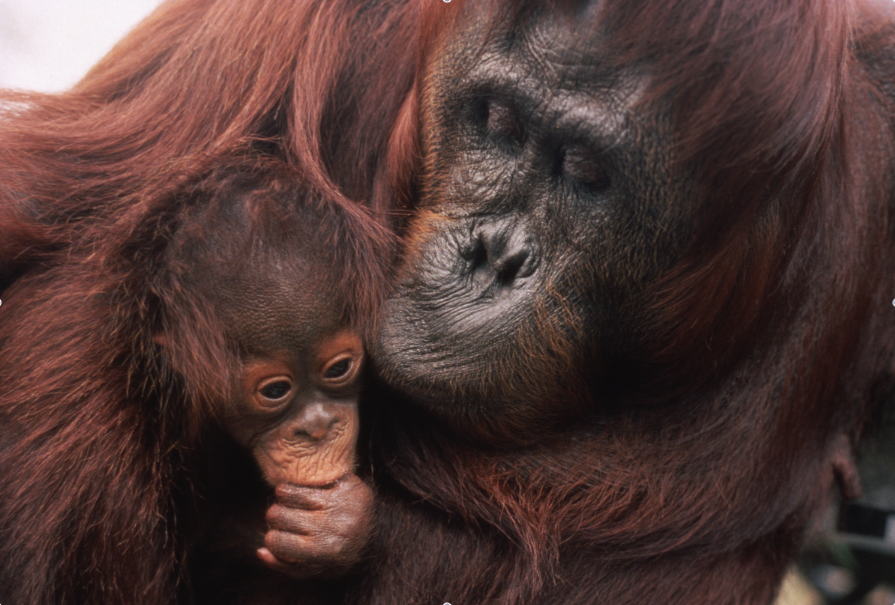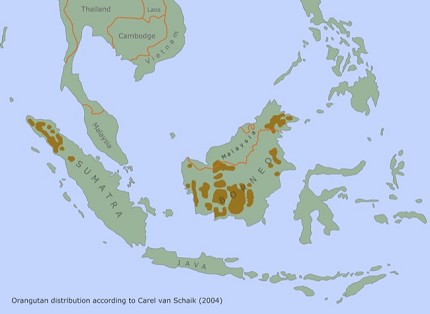This week we take things back to basics...What animal are we helping to save , how and why?
The animal
About a million years ago, orangutans lived throughout much of eastern Asia, from Java in the south, right up into Laos and southern China. Today they are found only on the islands of Borneo and Sumatra - both areas of the country of Indonesia. They are the only great ape that lives in Asia and no where else. There are two species of orangutan - the Bornean orangutan (P. pygmaeus) and the Sumatran orangutan (P. abelii). The two species express slightly different physical characteristics. The latter comes from Sumatra and is classified by a narrower face and longer beard than the Bornean species. Bornean orangutans are slightly darker in colour and the males have wider cheek pads than their Sumatran relatives. Behavioural differences have also been observed between the two species; Sumatran orangutans are more frugivorous (fruit-eating) and there is more evidence of tool use than in Bornean orangutans. Under the IUCN (International Union for Conservation of Nature) Red List, the Sumatran orangutan is classified as critically endangered and the Bornean as endangered.
Orangutans are the largest arboreal mammal in the world. They are also the most arboreal of the great apes and spend most of their time in trees.The preferred habitat of the orangutan is low-lying peat swamp forest – they are rarely found in habitats over an altitude of 800m. Although they are found on both Borneo & Sumatra, their ranges are very limited.
Orangutans are wholly dependent on trees for their existence. They are perfectly adapted to life in the forest - they sleep in nests (yep - really! In nests built of leaves which they learn to construct from a young age).
They feed predominantly on fruit and travel with ease through the forest canopy, rarely descending to the forest floor. Primarily frugivorous (eating fruits), orangutans have an important role as seed disperses. They selectively chose ripe fruit whose seeds are adapted to withstand passage through the orangutans' gut. Once excreted, the seeds find themselves in their own little compost pile, which helps them to become established. Over 400 food types have been documented as part of the orangutans diet, and although it consists mainly of fruit, in times of scarcity orangutans will shift their eating habits to lower quality food, such as bark, leaves & termites (a valuable source of protein!), rather than travel to a different area. As well as acting as seed disperses, orangutans help to open up the forest canopy. This allows light to reach the forest floor, which once again helps the forest regenerate naturally. They are a vital cog in the workings of the rainforest ecosystem.
Orangutans are unique among the primate species. All the other apes and monkeys (check the difference between apes and monkeys here!) are social and gregarious (meaning enjoying the company of others or/and living together in groups) whilst the orangutan is semi solitary, the largest group being a mother and two offspring. Females are less solitary and may spend up to 25% with other orangutans. In contrast, male orangutans will spend less than 9% in association with other orangutans. Sumatran orangutans are more social and this social behaviour usually coincides with the simultaneous fruiting of the fig tree, which doesn't occur in Borneo.
Orangutans are the slowest breeding of all primates and have the longest inter-birth interval of almost eight years, of any land-based mammal. In other words they are the slowest reproducing animal on land... The female orangutan reaches puberty at ten years and will normally have her first infant between the age of 12 and 15. Offspring are dependent on their mothers for at least five years and with a life expectancy of 45 years plus, females will normally have no more than three offspring. With these factors combined, the orangutan population, especially small fragmented populations, are at considerable risk. They don’t have the capacity to recover from disasters that may strike a population. A slight rise in the adult female mortality rate by just 1-2% can drive a local population to extinction.
How we work... The Foundation works to protect this amazing species via five areas of work , detailed in a bullet point list here, where you can link to read all about the work of our Bornean and UK team!
And why.... We work in this way to help the numbers of wild orangutans to increase and to preserve the vital habitat they (and so many other species) need to survive. Most recently, orangutan numbers have declined... Please consider learning more about the threats facing these habitats by reading here. Remember it's so easy to learn more and help orangutans and their habitat by telling others and by helping out in any way. If you can outreach for the Foundation in any small way , please do email us on info@orangutan.org.uk. There any many reasons why to conserve a species - some reasons to conserve the orangutan are listed below...
- For Pongo pygmaeus there has been well over a 50% during the last 60 years (generation length estimated at 20 years, Wich et al. in press).
- For Pongo abelii there has been well over a 80% over the last 75 years (assuming a generation length of at least 25 years; Wich et al. in press).
- This decline continues, as forests within its range are under major threat. Most orangutans are outside of protected areas, including within potential logging areas and conversion forests.
- The decline of the species is predicted to continue at this rate, primarily because of forest loss due to conversion of forest to agriculture and fires. The majority of remnant wild populations are located outside of protected areas, in forests that are exploited for timber production or in the process of being converted to agriculture.
-
Orangutan feeding habits have been described as “boom or bust”. Cheryl Knott in West Borneo reported that when fruit is plenty, the orangutans consumed many more calories. Females had higher estrogen levels and mating was more frequent. The opposite occurred when availability of fruit was low. Orangutans will shift their eating habits to lower quality food rather than travel to a different area. Therefore logging could have drastic effects on reproduction, by increasing birth intervals, due to lack of high quality food. For a species that already has extremely longer inter-birth intervals this is a very serious consequence.
Thank you!





